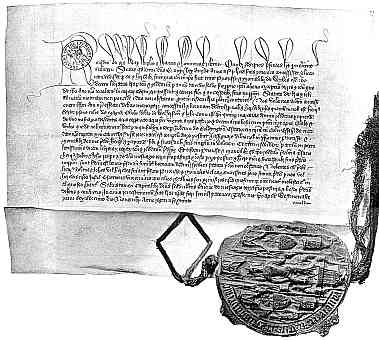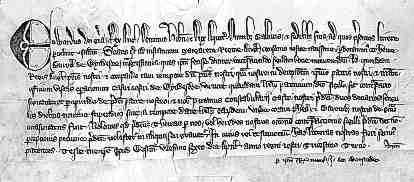


If you are looking at this page without frames, there is more information about medieval writing to be found by going to the home page (framed) or the site map (no frames).
| Letters Patent | ||
| The term letters patent in its most general form refers to a letter delivered open with the royal seal attached, designed to be read as a proclamation. This would seem to give it much in common with a charter or a writ, and the terms overlap to a degree, but in the developing complexity of written administration in the English royal chancery in the 13th century, it fits into a particular rung on the hierarchy of documents issued under royal authority. | ||
 |
An example of letters patent of Richard II, from 1381 (London, National Archives, Ancient Deeds, A. 5267). (From Johnson and Jenkinson 1915) | |
| The above example, at this magnification unreadable but able to be admired for its fine formal qualities, is a licence to alienate in mortmain, which is just fancy medievalspeak for a transfer of property, of certain lands to Wix Priory. It has the general appearance and imposing qualities of a charter, written with a certain amount of calligraphic flourish on a single sheet of parchment. The great seal is attached with silk cords. | ||
| In general letters patent are addressed in less florid language than charters and do not have such long witness lists. The handwriting is elaborate, but not quite so formal as that of a charter. Letters patent may deal with highly significant matters, but of a broader ranging nature than charters. While charters were used for granting rights in perpetuity, letters patent could be used to grant privileges to an individual for their lifetime only. The example above, like a charter, served as a title deed to property, but many other matters could be covered by letters patent. They could be used to issue an order or proclamation, which makes them rather like a writ. If we don't watch out we will be on the terminological roundabout again. | ||
 |
||
| Letters patent of Edward I (Eton College Muniments, W.360). (From New Palaeographical Society 1909) | ||
| The above example is a pardon by the king to one of his subjects for forging the great seal for his personal advantage. | ||
| Like charters, letters patent were sent out from the royal chancery and so became dispersed and scattered. There is a certain randomness about the likelihood of finding one out there in the wild. However, from 1201 copies were kept by the chancery on Patent Rolls; great long strips of joined sheets of parchment with copies of the letters entered in chronological order. However, these rolls are not complete. For one thing, private citizens who were beneficiaries of letters patent had to pay to have them enrolled, which some did in order to have their title deeds verified. Documents issued under the privy seal were not enrolled. | ||
| Letters patent could be issued by direct authority of the offices of the chancery, but many were issued in response to petitions from private citizens or institutions. | ||
| Segment from a petition of the Abbot and convent of Tewkesbury, of 1449, requesting letters patent under the great seal (London, National Archives E.28/79/30), by permission of the National Archivese. | ||
| By the later middle ages, the procedure for generating letters patent could involve several steps, including a petition from the grantee, a letter from the office of the signet, a warrant from the office of the privy seal, letters patent under the great seal and an entry on the Patent Rolls. The practice of getting an old grant confirmed, especially at the start of a new reign, also increases the odds that any particular transaction may have left a trace somewhere in the system. | ||
| In the English context, the term letters patent therefore develops a fairly specific meaning by the later part of the middle ages with respect to a series of bureaucratic processes in the royal chancery. In a broader European context, the term can be used more generally for a formal letter, delivered open with seal attached. | ||
 |
Letters patent from the abbots of Beaubec and Valioires to the archbishop of Rheims and the bishop of Amiens (Archives de l'Aube, 3 H 120). (From de Boüard 1929) | |
| The above example shows letters patent in the form of a very formal document in an entirely ecclesiastical context, unrelated to government bureaucracy. The seal of dignity depicts an abbot with his mitre and crozier, and is attached to a tongue cut from the bottom of the document. It is a formal public document. | ||
|
|
||
|
If you are looking at this page without frames, there is more information about medieval writing to be found by going to the home page (framed) or the site map (no frames). |
||